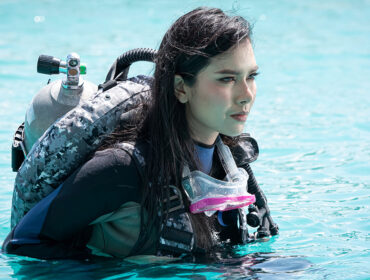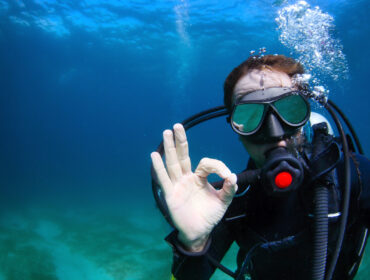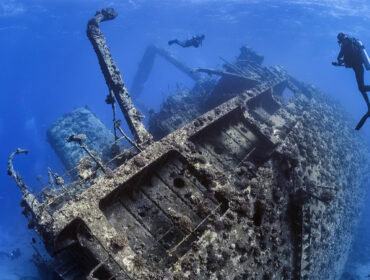As someone who shoots underwater often, I get asked this question all the time: Which is better for underwater photography: freediving vs scuba diving? The truth is, it really depends. They each offer something completely different. One gives you time and control, while the other gives you speed and intimacy. Over the years, I’ve learned when to choose one over the other, and how both have shaped my approach as an underwater photographer.
In this article, I’ll break down the pros and cons of each, share how I use them in my work, and help you figure out which method makes the most sense for your next underwater shoot.
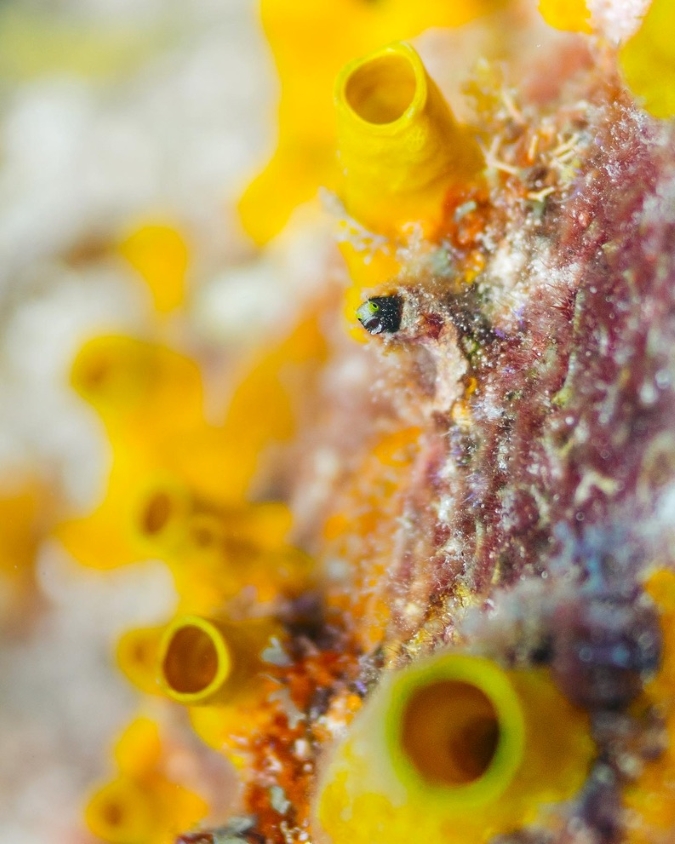
The Pros and Cons of Scuba Diving for Photography
There’s a reason scuba is the go-to for most underwater photographers. Most people even forget that there’s other options for taking underwater photos unless its while scuba diving. It’s stable, reliable, and gives you time, which is a luxury when it comes to working underwater. You can spend 30 to 60 minutes at depth, which means more chances to wait for the right light, the perfect composition, or that one curious subject to come close enough.
For technical photography, especially when using strobes, tripods, or macro gear, scuba is hard to beat. You’re not rushing, and you can carefully dial in your settings, reposition lights, and patiently observe animal behavior. You’re also able to carry heavier equipment, which opens up creative possibilities that just aren’t feasible while on breathhold.
But scuba has its downsides too. For starters, the gear is bulky and restrictive, which slows you down a lot. On top of that, bubbles can scare off animals like whales, dolphins, and even some reef fish. Depending on what kind of wildlife you’re shooting and how quickly you need to react, scuba may not even be an option. For example, if you’re observing a bait ball that’s constantly on the move, you’d be too restricted on scuba to try and chase them.
In short: scuba is ideal for control, patience, and precision — but less so for stealth and spontaneity.
The Pros and Cons of Freediving for Photography
On the other side of the spectrum, freediving feels like flying. With no tank, no bubbles, and no heavy equipment weighing you down, you move through the water much more quietly and freely. For wildlife photography, especially with dolphins, whales, or fast-moving bait balls, this can make all the difference. You’re less intrusive, more agile, and able to react quickly to the moment.
Freediving also opens up creative possibilities that scuba simply doesn’t. You can surface, dive again, reposition from above, or shoot split-level images without dealing with buoyancy adjustments or equipment drag. In shallow environments like reefs, cenotes, and surf zones, freediving gives you the edge in flexibility and flow.
But freediving comes with obvious limitations. Your time underwater is short, usually just 30 seconds or a minute, so you have to be fast, focused, and well-prepared. It’s often helpful to map out the shots you’re looking to take ahead of time so that you don’t miss the opportunity once it’s presented in front of you. There’s no room for adjusting settings mid-dive, and you might only get one or two attempts before you need to recover. It also requires physical and mental training to stay calm and efficient at depth. Shooting on a breathhold is a completely different experience and requires a different level of control over your breath to be effective. And because you’re also surfacing often, having good control over your buoyancy with the right amount of weight is also a crucial factor to master.
Freediving isn’t better or worse than scuba — it’s just a completely different way of working. One that demands more from you, but gives you a certain closeness in return.
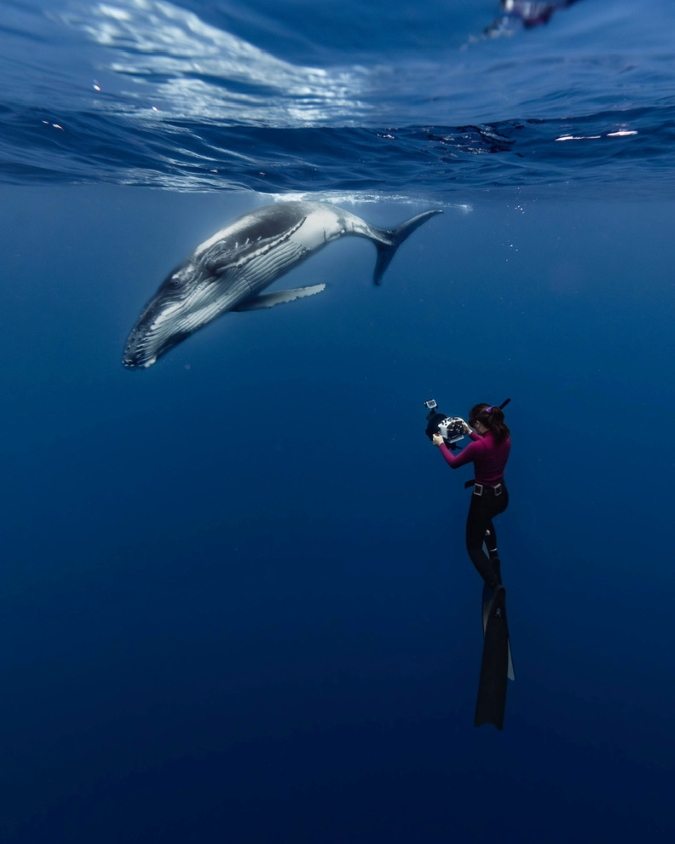
What Kind of Photography Are You Trying to Do?
Your choice between scuba and freediving should always come down to the type of photography you’re aiming for.
If you’re shooting large marine life like whales or dolphins (animals that are sensitive to noise), freediving is almost always the better choice. The silence and fluidity of movement allow for more intimate interactions, and in many cases, you’ll get more natural behavior from the animals.
For technical or macro work (think nudibranchs, coral textures, or controlled lighting), scuba diving is king. It gives you the time and stability to really lock in composition and lighting without rushing.
Shooting models or artistic concepts underwater? That could go either way. If you’re shooting in a pool or shallow environment where the model is also a strong freediver, ditching the tanks can offer more flexibility and elegance. But if you’re at depth or working on complex lighting, scuba may offer the consistency and control you need.
And if you’re chasing fast action, like bait balls or reef predators, the choice may depend on the conditions that day — and how fast you need to get in the water.
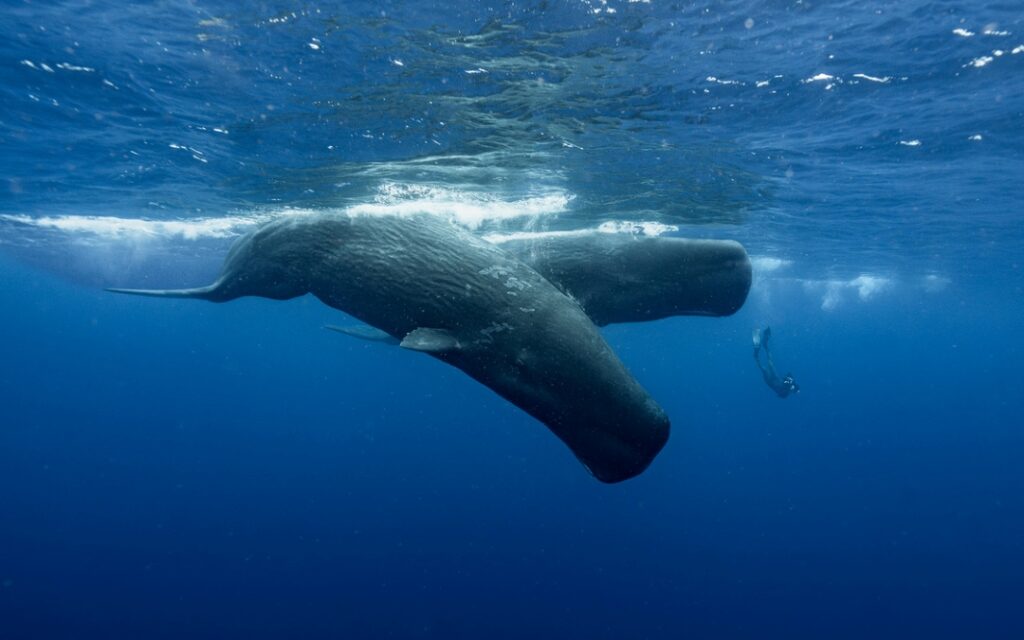
My Current Underwater Setup for Both Freediving and Scuba
You might be expecting me to use different gear depending on the type of dive I’m doing, but actually, they’re exactly the same (for now).
For both scuba and freediving, I shoot with a Sony a7RV mirrorless camera in a Marelux underwater housing, often with a wide-angle 16-35mm lens. I don’t own any strobes or video lights (yet!) because this is an expensive hobby and we’re taking it one step at a time, but in the future I’d love to have a few lights to bring on scuba dives and to start shooting macro wildlife.
While diving, I typically focus my efforts on photography (it’s my first love), but I also have an action camera mounted to my camera dome so that I can also be shooting video at the same time. I’ve been cycling through different action cams, but right now I’m using the DJI Osmo Action 5 and I love it so far.
Whether I’m diving or breath-holding, everything I use fits neatly in my Pelican case and camera backpack. It does get quite heavy when I’m traveling, but it’s a sacrifice I’m willing to make in order to bring all of the things I need!

Conclusion: How I Choose Between Freediving vs Scuba Diving
So, which is better for underwater photography — freediving vs scuba diving? It really depends!
Both offer different strengths, and both have shaped the way I see and shoot underwater. I use scuba when I need time, control, and technical precision. I use freediving when I want to move freely, connect with animals, or create something more spontaneous and fluid.
The truth is, if you want to be a well-rounded underwater photographer, learning both is the real superpower. The more tools you have in your toolbox, the more possibilities you’ll find beneath the surface.



